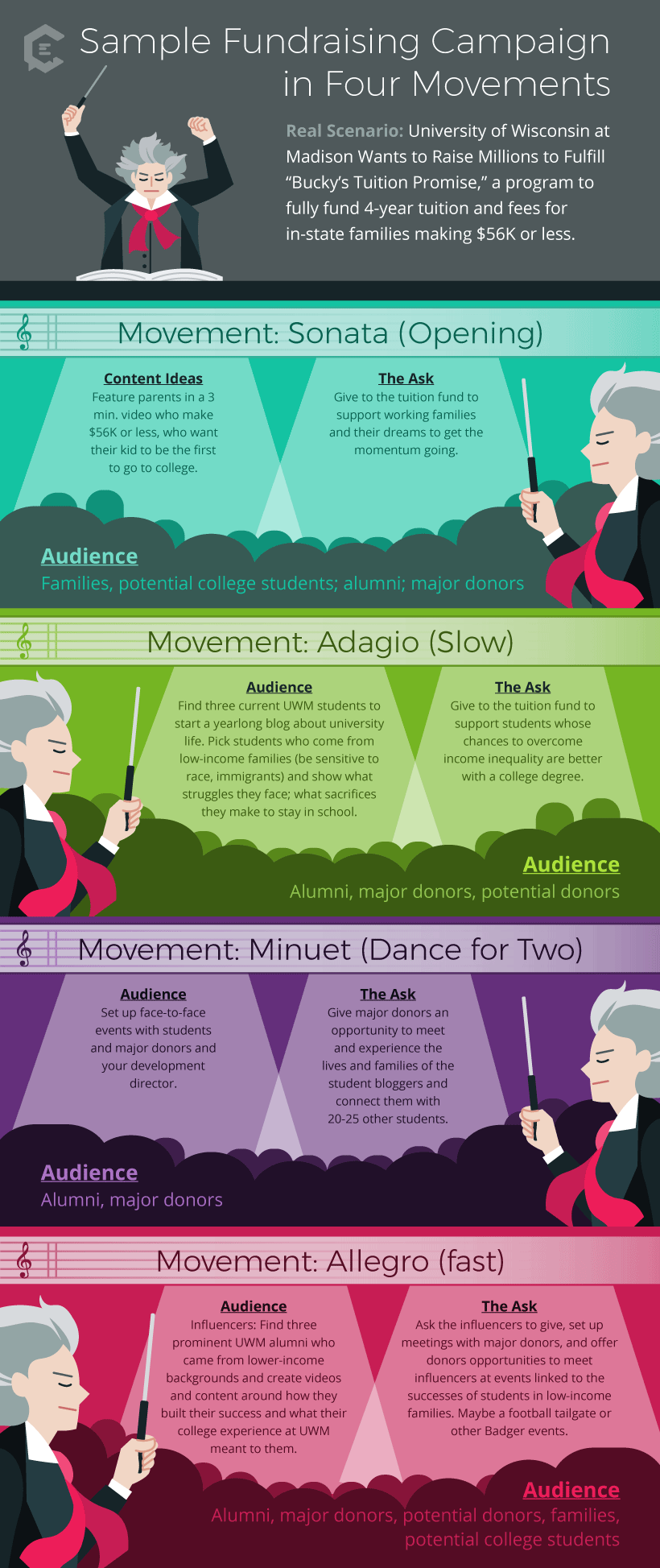One of the world’s best known and frequently played symphonies, Beethoven’s Symphony No. 5 opens with four dramatic notes repeated: “ta-ta-ta-TAAA… ta-ta-ta-TAAA.”
As development directors and content creators drafting your plans for the upcoming fundraising season, now is the time to brainstorm, identify and cultivate the “ta-ta-ta-TAAA” notes within your campaign ideas.
Think of composing your campaign and its interrelated content as Beethoven did – with the panache of the four-movement form. Like a symphony, a content campaign to raise funds for a nonprofit or an educational institution should have multiple strategies that progress at different tempos.
Beethoven’s Fifth comprises four movements:
1) an opening sonata;
2) an andante;
3) a scherzo
4) an attacca to the finale
How do these Italian musical terms translate to a fundraising campaign?
In this article, I will explain some guidelines to determining your content strategies, and help you see how they can work together to help you meet your content creation needs – which ultimately serves to meet your fundraising goals.
Each nonprofit and/or educational institution has varying budgets for content creation and campaign development, so the strategies I’ve selected aren’t formulaic. More so, this article attempts to get your brain revved up to think about campaign approaches creatively and adjust your strategies based on your budget.
Symphonic campaign development
Frame your campaign with four key strategies (symphonic movements), and pace them throughout the year so they carry a single motif that unifies the entire campaign.
The strategies should reflect and connect to your donor-base and best approaches that take into consideration your base’s different ages, giving levels, giving dispositions and preferred methods or platforms.
Each strategy should be able to stand alone and reflect your organization’s mission and vision. However, when planned and composed to move together and towards each other like a symphony, each of your campaigns’ strategies amplify your message.
Movement I: Sonata – Establishing your motif
Choosing a clear, catchy and singular motif will help you tie all the ideas of next year’s fundraising season together.
Some development professionals might call this exercise establishing a theme, slogan or tagline, but a motif is more nuanced than that. It serves as a visible network of symbols that are present in all your campaign strategies, and their design. Motifs can be seen repeating and working on multiple levels. It strives to show symbolically what your organization does, and why your organization means something to your donors.
For example, the American Civil Liberties Union’s (ACLU) current motto, “We won’t back down,” speaks to the organization’s work to protect the rights of underrepresented communities. In the words, we find symbolizes: standing tall, pushing back, not falling into intolerance. The ACLU’s feisty vitality is what its donors love, especially after a gutsy move post-election to take out a full-page ad in the New York Times. When the ACLU launched its ad, they raised $24 million dollars in less than a week, and maintains their position as the “IT” organization to give to during the Trump presidency.
Keep in mind, not only should the motif be symbolic, but plan for repetition. Can you hear cadence and crescendo in the words as they are said together? As the phrase gets repeated throughout the campaign, can donors see layers and deeper significance related to your organization’s work?
Movement II: Andante – Building momentum at a walking pace
Not all campaign openings have their “ta-ta-ta-TAAA” at the start with a news media/op-ed piece like the ACLU’s approach.
Establishing steady contacts with donors via appeals, e-newsletters and events are the consistent ways of cultivating donors. Hence, andante (walking pace). This strategy requires planning the year out over a series of articles, one-page features and content, which will provide consistent contact with donors and maintain their engagement. For this year’s campaign, you might follow one project within the organization’s portfolio, and document its trials, its lessons learned, and its success in a serial format in short articles and/or a podcast.
One important thing to remember with online content is to make the donation button prominent and the process easy. An innocent mistake many nonprofits do is bury the donation link at the bottom or end of the e-newsletter or appeal. Some readers may not get to the end. Some get discouraged with the amount of information needed to make a donation that they give up half way through and leave the donation process.
Keep in mind that donors who are already subscribed to your organization’s newsletter appreciate the opportunity to give if the content in the newsletter compels them to give. Make your needs known and prominent. Make links easy to give online and shareable. Some nonprofits share a post on social media or allow donors to start their own campaigns.
Movement III: Scherzo – A playful manner of raising awareness
Most everyone has heard of the Ice Bucket Challenge. Yes, the playful approach to bringing international awareness, hope and lightness to a debilitating neurodegenerative disease commonly called Lou Gehrig’s Disease. Their “Every Drop Adds Up” campaign raised $115 million dollars for the ALS Association in the summer of 2014.
Every campaign can benefit from mobilizing social media and its multiplying effect for fundraising. Finding that next idea that creates a viral public response and generates that many donations isn’t easy though. But let’s go to the origin story of this strategy: The idea emerged between a son with Lou Gehrig’s and a mom who wanted to help him after a researcher said it would take a billion dollars to find a cure. What does the son say: “Let’s do it!”
The best campaign ideas come from your constituents, the people who have a reason to find the cure, solve the problem, move mountains to create change because their lives or the lives of the people they love depend on it.
Their stories, in their voice, will move your donors to do crazy things. Note: The unspoken symbolism of the challenge should not be lost: If you can feel the sensations, and jump up from the chill of the ice water running over your head and back, that physical reflex is something someone with ALS can lose when their muscles weaken. But never is it presented in the messaging with a didactic-holier-than-thou tone or as a cautionary tale. Instead it’s framed as a prank, and a celebration of childhood innocence.
Movement IV: Attacca – From momentum go straight on
Both the ACLU and the ALS examples show how bold moves, or playful approaches, must resonate on multiple levels. For every fundraising campaign (and symphony) the donor/listener must feel a real sense of drama and get to a point of empathy. Only then will they feel how their contribution can make an impact.
As Beethoven once said about his selection of musical notes and keys: “Many assert that every minor piece must end in the minor. Nego! … Joy follows sorrow, sunshine — rain.” The movements of a fundraising campaign should aim to show the sorrow and rain, but the uptick to the drama is the outpouring of joy and sunshine that inspires us in the heart and triggers the altruism inherent in all of us.
A set of strategies to add to your fundraising playbook
After reading ClearVoice’s Content Marketing Best Practices: Higher Education & Nonprofits, consider four main strategies your staff, volunteers and budget can handle for the upcoming fundraising year.
Think through what will be the campaign’s motif:
- What inspires the work?
- What are the concerns and problems you are attempting to address in the bigger context?
- What key initiatives in your programs best show this symbolically?
- Who are the people whose personal stories and struggles symbolically represent the people you want the campaign to serve?
- Consider how to express intersectionality of issues by approaching stories about a few people from different angles.








